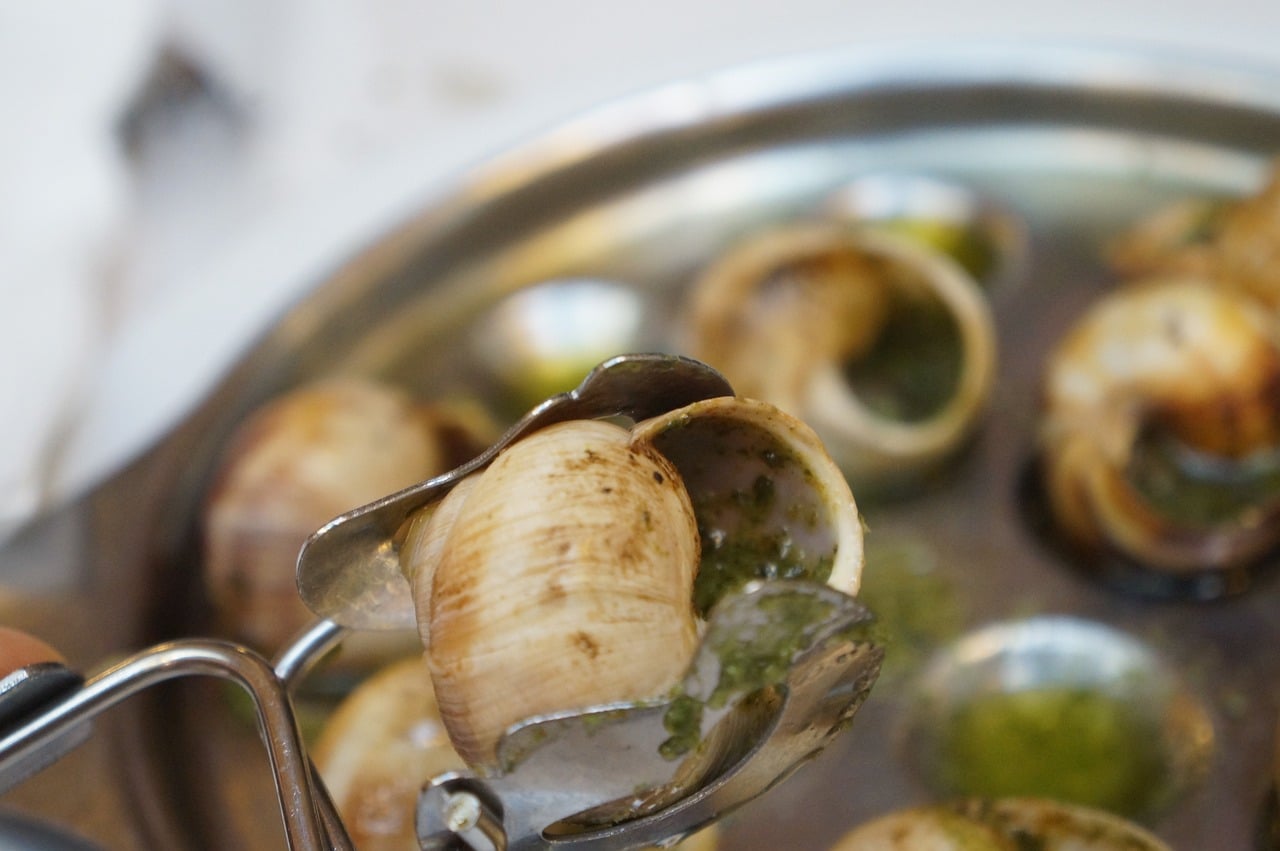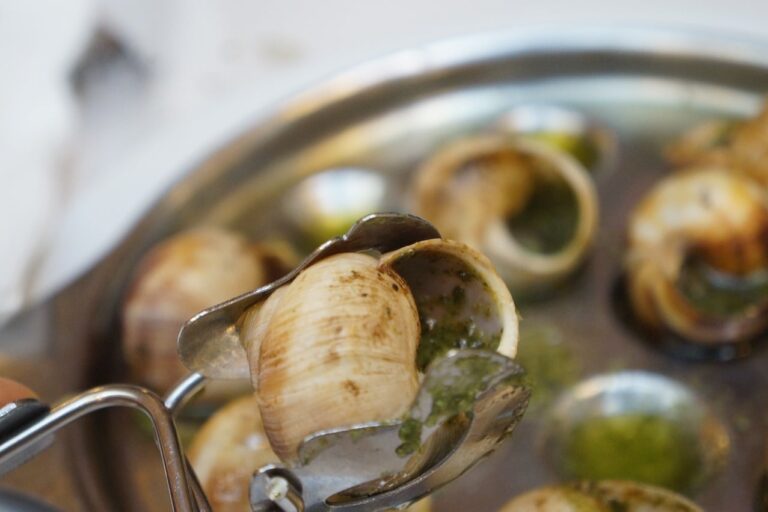
Escargots de Bourgogne, a national dish of France, is a culinary delight that has been savored for centuries. This delicacy, made from land snails cooked in garlic butter, parsley and white wine, is often associated with luxury and sophistication.
The dish’s rich history and unique preparation method contribute to its status as an iconic French cuisine. Let’s delve into the fascinating world of Escargots de Bourgogne.
Our team at Remitly created this guide as part of our series that celebrates the cuisine of our customers around the world.
The History of Escargots de Bourgogne
Escargots have been part of human diet for thousands of years. Archaeological evidence suggests that prehistoric people in regions now known as France were consuming these mollusks long before the advent of written history. However, it was during the Roman era when escargots were first recognized as a gastronomic treat.
In the Middle Ages, escargots were considered peasant food. But by the 19th century, they had become a symbol of French haute cuisine. Today, Escargots de Bourgogne is recognized worldwide as a classic French dish.
Ingredients and Preparation Method
The primary ingredient in Escargots de Bourgogne is Helix pomatia snails. These are often used due to their large size and abundant meat content. The snails are thoroughly cleaned and then cooked in court-bouillon—a flavorful broth made with vegetables and herbs.
After cooking, the snail meat is removed from the shell and mixed with butter, garlic, parsley, salt and pepper—a mixture known as “beurre d’escargot”. The seasoned meat is then returned to the shell along with more beurre d’escargot on top. Finally, it’s baked until golden brown.
Recipe for Escargots de Bourgogne
This recipe will guide you through the process of preparing Escargots de Bourgogne at home. It’s a simple yet elegant dish that can impress your guests with its unique flavors and presentation.
Ingredients
- 24 canned Burgundy snails (Helix pomatia)
- 1 cup unsalted butter, softened
- 5 cloves garlic, minced
- 1 small bunch fresh parsley, finely chopped
- Salt and freshly ground black pepper to taste
- 1/4 cup dry white wine
- Baguette slices for serving
Instructions
- Preheat your oven to 375°F (190°C).
- In a bowl, combine the softened butter, minced garlic, chopped parsley, salt and pepper.
- Drain the canned snails thoroughly.
- Place each snail into a shell or an escargot dish.
- Fill each shell or dish compartment with the butter mixture until it completely covers the snail.
- Drizzle white wine over the filled shells or dish compartments.
- Bake in the preheated oven for about 10 minutes or until the butter is bubbling and slightly golden.
- Serve hot with baguette slices on the side.
The Role of Escargots in French Cuisine
Escargots hold an esteemed place in French cuisine—particularly within Burgundy region where this dish originates from. They’re often served as an appetizer in French restaurants, both within and outside France.
The dish is appreciated for its unique flavor profile. The earthy taste of the snails combined with the rich, garlicky butter creates a complex yet balanced palate. It’s a testament to the French culinary philosophy of transforming simple ingredients into extraordinary dishes.
Regional Variations of the Dish
While Escargots de Bourgogne is well known, there are regional variations throughout France. In Provence, for example, escargots are often prepared with tomatoes and herbs de Provence—a mixture of dried herbs typical in southern France.
In Alsace, another region in eastern France, escargots might be cooked with Riesling wine instead of white Burgundy. These regional differences highlight the diversity and adaptability of French cuisine.
Pairing Suggestions for Escargots de Bourgogne
When it comes to pairing wine with Escargots de Bourgogne, Chablis or any other dry white Burgundy wine is often favored. The crisp acidity and mineral notes in these wines complement the richness of the dish without overpowering its delicate flavors.
For those who prefer red wine, Pinot Noir from Burgundy can also be an excellent choice. Its light body and high acidity balance out the buttery richness of escargots while its earthy undertones echo those in the snails themselves.
Understanding the Appreciation for Snails in France
Snails have been a part of French culinary tradition for centuries. Their unique texture and flavor, combined with the ritualistic preparation and eating process, make them a fascinating subject of gastronomic interest.
The appreciation for snails in France extends beyond their taste. They’re also valued for their ecological role as decomposers in the ecosystem. This respect for nature is deeply ingrained in French culture and is reflected in their cuisine.
Exploring Other Iconic French Dishes
Escargots de Bourgogne is just one example of the rich culinary heritage of France. Other iconic dishes include Coq au Vin—a chicken dish cooked with wine, lardons, mushrooms, and garlic; Bouillabaisse—a traditional Provençal fish stew; and Ratatouille—a vegetable stew from Nice.
Each dish tells a story about its region’s history, culture, and local ingredients—making French cuisine not just a gastronomic journey but also an exploration into the heart of France itself.
The Broader Cuisine of France
French cuisine is renowned worldwide for its quality and diversity. Each region in France has its own distinct culinary traditions influenced by local ingredients and historical influences.
Regional Specialties
In Normandy, seafood dishes are popular due to its coastal location while Alsace is known for its German-influenced cuisine like sauerkraut and beer-braised meats.
The south of France boasts Mediterranean flavors with dishes like Bouillabaisse from Provence and Ratatouille from Nice featuring prominently.
Central regions such as Lyon are recognized as gastronomic centers where traditional French cooking techniques are celebrated in dishes like Coq au Vin and Quenelles.
French Cooking Techniques
French cuisine is also known for its cooking techniques. From the slow-cooking method used in making cassoulet, a hearty meat and bean stew from Languedoc, to the precision required in creating delicate pastries like croissants and macarons—these techniques are integral to the identity of French cuisine.
French cooking techniques have influenced cuisines worldwide, including not only neighboring countries with a strong French influence like Belgium, Monaco, Andorra, and Switzerland. But also, remote countries where the country has left a cultural imprint such as Oceania, Vietnam, Lebanon, Comoros, and northern Africa.
The Importance of Fresh Ingredients
Freshness of ingredients is highly valued in French cooking. Markets across France are filled with local produce, artisanal cheeses, fresh seafood, and quality meats. These ingredients form the basis of French dishes, contributing to their depth of flavor and overall quality.
The Art of Dining
Dining is considered an art form in France. Meals are often multi-course affairs enjoyed over several hours. This appreciation for food extends beyond just eating—it’s about savoring each bite, enjoying good company, and celebrating life through food.
In conclusion, French cuisine offers a rich tapestry of flavors, techniques and traditions that make it one of the most revered culinary cultures in the world. Whether you’re sampling Escargots de Bourgogne or exploring other regional specialties, you’re sure to find something that delights your palate.
Visit the homepage, download our app, or check out our Help Center to get started.
